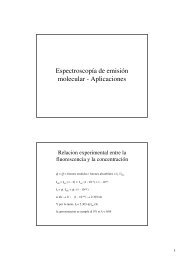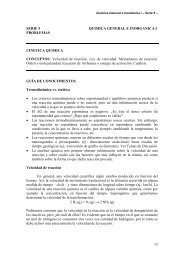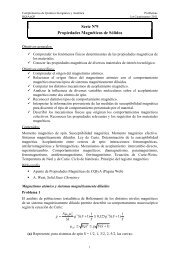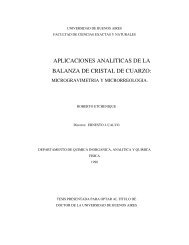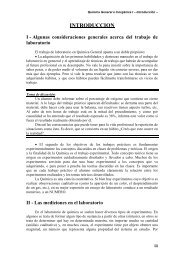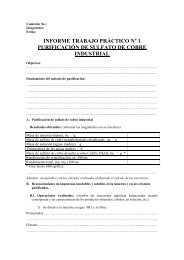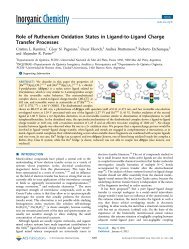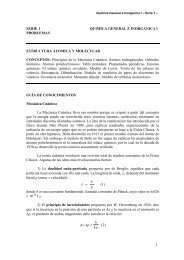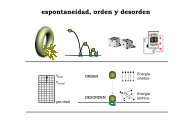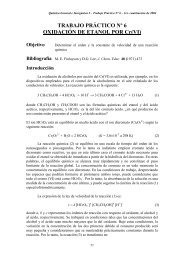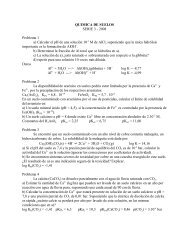Determination of Carbon-Carbon Bond Length from the Absorption ...
Determination of Carbon-Carbon Bond Length from the Absorption ...
Determination of Carbon-Carbon Bond Length from the Absorption ...
You also want an ePaper? Increase the reach of your titles
YUMPU automatically turns print PDFs into web optimized ePapers that Google loves.
<strong>Determination</strong> <strong>of</strong> <strong>Carbon</strong>-<strong>Carbon</strong> <strong>Bond</strong> <strong>Length</strong> <strong>from</strong> <strong>the</strong><br />
<strong>Absorption</strong> Spectra <strong>of</strong> Cyanine Dyes<br />
Richard S. Moog<br />
Franklin and Marshall College, Lancaster, PA 17604<br />
The study <strong>of</strong> <strong>the</strong> absorption spectra <strong>of</strong> a series <strong>of</strong> cyanine<br />
dyes is <strong>of</strong>ten used in <strong>the</strong> undergraduate laboratory as an<br />
example <strong>of</strong> <strong>the</strong> application <strong>of</strong> elementary quantum mechanics<br />
to a chemical system (1-4). The lowest electronic transition<br />
<strong>of</strong> <strong>the</strong>se dyes involves <strong>the</strong> conjugated r system and<br />
generally lies in <strong>the</strong> visible region. Although some fairly<br />
so~histicated calculations (5) have been made for <strong>the</strong>se<br />
types <strong>of</strong> dyes, <strong>the</strong> agreement with experimental results is<br />
Door. The sim~le varricle-in-a-box (or free electron) model.<br />
briginally proiosid by Kuhn (6) has been found toprovidd<br />
more satisfactory agreement, even though some <strong>of</strong> <strong>the</strong> assumptions<br />
made are somewhat unrealistic.<br />
Consider, for example, <strong>the</strong> ~olvmethine dyes shown in<br />
Figure 1. he conjugated r syite& <strong>of</strong> <strong>the</strong>se dyes are commonly<br />
modelled as providinga "particle-in-a-hox"potential<br />
energy surface, in which <strong>the</strong>r ekctrons are allowed to move<br />
freely (<strong>the</strong> free electron model). That is, it is assumed that<br />
<strong>the</strong> potential energy is constant along <strong>the</strong> polymethine chain<br />
and that it rises sharply to infinity at <strong>the</strong> two ends (<strong>the</strong><br />
nitroeen atoms). The enerw levels for this svstem are eiven<br />
by th; eigenval;es <strong>of</strong> <strong>the</strong> s&odinger equatibn for a<br />
constrained to a one-dimensional box <strong>of</strong> length L:<br />
En = h2n2/[8mL2]; n = 1,2,3,. .. (1)<br />
where m is <strong>the</strong> mass <strong>of</strong> <strong>the</strong> electron and h is Planck's constant.<br />
The Pauli principle is <strong>the</strong>n applied to this set <strong>of</strong><br />
energy levels, resulting in <strong>the</strong> determination that <strong>the</strong> lowest<br />
energy transition will occur <strong>from</strong> <strong>the</strong> level with n = N/2 to<br />
that with n = (N/2) + 1, where N is <strong>the</strong> total number <strong>of</strong> r<br />
electrons in <strong>the</strong> chain. This model predicts that <strong>the</strong> lowest<br />
energy transition in <strong>the</strong>se systems is described by<br />
AE = hc/h = h2(~<br />
+ 1)/[8nL2] (2)<br />
Note that eq 2 relates <strong>the</strong> "1ength"<strong>of</strong> <strong>the</strong> box to <strong>the</strong> ahsorption<br />
energy and wavelength for each dye.<br />
The analysis described by many previous workers is to<br />
determine a chain length, L, for each dye using eq 2 and <strong>the</strong><br />
energy corresponding to <strong>the</strong> experimentally obtained absorption<br />
maximum (A,). This "experimental" chain length<br />
is <strong>the</strong>n compared to a "<strong>the</strong>oretical" length, generally provided<br />
by a relation <strong>of</strong> <strong>the</strong> form<br />
L=(b'+o)Xr (3)<br />
where b' represents <strong>the</strong> "number <strong>of</strong> bonds" in <strong>the</strong> chain, r is<br />
<strong>the</strong> average hond length, and a is an emprical parameter<br />
which increases <strong>the</strong> effective number <strong>of</strong> bonds in <strong>the</strong> chain to<br />
account for <strong>the</strong> polarizability <strong>of</strong> <strong>the</strong> groups at <strong>the</strong> two ends.<br />
The value <strong>of</strong> r is set equal to <strong>the</strong> hond length <strong>of</strong> benzene<br />
' Previous authors (7) have commented that "[tlhe polnt . . . must<br />
be decided arbitrarlly. Apparently <strong>the</strong> most satisfactory convention is<br />
to place this wall [at <strong>the</strong> end <strong>of</strong> <strong>the</strong> '%ox"] . . . one bond distance<br />
beyond <strong>the</strong> end atoms <strong>of</strong> <strong>the</strong> conjugated system."<br />
Some authors omit <strong>the</strong> parameter a completely. In this case, <strong>the</strong><br />
agreement between "experimental" and "<strong>the</strong>oretical" lengths is generally<br />
very poor-see, for example, refs 1 and 2.<br />
Figure 1. Dye 1: 1.Irdiethyl-4.4'-cyanine iDdides (x = 0. 1. 2. 3): Dye 2a (R =<br />
5): 3.3'diethylthiacyanine iodides (i = 0. 1. 2, 3): Dye 2b (R = 4: 3.3'-<br />
dielhyfoxacyanine iodides (x = 1. 2. 3).<br />
Table 1. Partlde-in-a-Box Parameters for Three Serles ol<br />
Polymethlne Dyes<br />
Dyeilb x= I 6 8 483 1.15 0.261<br />
x=2 8 10 578 1.39 -0.0096<br />
x=3 10 12 681 1.64 -0.211<br />
' Elfenivs lengm calculated using A, and eg 2.<br />
OCalculated using eqs 2 and 3.<br />
oafs <strong>from</strong> ref I.<br />
(0.139 nm), and <strong>the</strong> value <strong>of</strong> b' is generally (although not<br />
universally) increased by 2 over <strong>the</strong> actual number <strong>of</strong> bonds<br />
to account for <strong>the</strong> extension <strong>of</strong> <strong>the</strong> r system for one hond<br />
length beyond each <strong>of</strong> <strong>the</strong> terminal nitrogen nuclei.' This<br />
leaves only <strong>the</strong> value <strong>of</strong> a to be determined. This parameter<br />
is expected to be constant for a given series <strong>of</strong> dyes. Table 1<br />
shows <strong>the</strong> values <strong>of</strong> a which provide fits to <strong>the</strong> experimental<br />
data.2 It is clear that a does not remain constant for a given<br />
series <strong>of</strong> dyes, as has been noted previously (I).<br />
508 Journal <strong>of</strong> Chemical Education
An Alternative Approach<br />
This standard annroach and <strong>the</strong> results ohtained raise a<br />
number <strong>of</strong> questio& Why is <strong>the</strong> "number <strong>of</strong> bonds" <strong>of</strong>ten<br />
increased by 2 (as opposed to 1 or 0 or some o<strong>the</strong>r value) over<br />
<strong>the</strong> numher actually present Why is <strong>the</strong>re an additional and<br />
separate adjustment to <strong>the</strong> "numher <strong>of</strong> bonds" in <strong>the</strong> chain<br />
with <strong>the</strong> parameter LY Why is a not constant for a given<br />
series <strong>of</strong> dves What is <strong>the</strong> phvsical interpretation <strong>of</strong> a negative<br />
valu' <strong>of</strong> LY Many (if nit all) <strong>of</strong> <strong>the</strong>se questions ire<br />
difficult to answer, suggesting that a more easily interpretable<br />
model is desirable.<br />
An alternative approach to <strong>the</strong> applications <strong>of</strong> <strong>the</strong> particle-in-a-boxmodel<br />
to <strong>the</strong>se systems is to slightly modify eq 3<br />
to <strong>the</strong> following:<br />
where b is <strong>the</strong> actual number <strong>of</strong> bonds between <strong>the</strong> nitrogens,<br />
1 is <strong>the</strong> average bond length along <strong>the</strong> chain for a given<br />
series<strong>of</strong> dyes, and y is an empirical parameter expected to be<br />
constant for a series <strong>of</strong> dyes and that accounts for all <strong>of</strong> <strong>the</strong><br />
additional leng<strong>the</strong>ning <strong>of</strong> <strong>the</strong> chain beyond <strong>the</strong> two end<br />
atoms.3 Ra<strong>the</strong>r than setting <strong>the</strong> average bond length in <strong>the</strong><br />
chain to be equal to <strong>the</strong> bondlengthin benzene, <strong>the</strong> ualue <strong>of</strong> 1<br />
is to be determined <strong>from</strong> <strong>the</strong> data. Note that within a given<br />
series <strong>of</strong> dyes only <strong>the</strong> number <strong>of</strong> bonds along <strong>the</strong> chajn, b,<br />
varies. The values <strong>of</strong> 1 and 7 are assumed to be constant and<br />
unknown. Thus, <strong>from</strong> <strong>the</strong> absorption spectra, <strong>the</strong> effective<br />
chain length, L, for each dye in a series can be determined<br />
usine ea 2. If L is <strong>the</strong>n dotted aeainst <strong>the</strong> total number <strong>of</strong><br />
bonzs, i, in <strong>the</strong> chain, <strong>the</strong> result & expected to be a straight<br />
line with slope 1, <strong>the</strong> average bond length, and an intercept,<br />
y. This analysis thus provides an example <strong>of</strong> a typical application<br />
<strong>of</strong> spectroscopy to chemical problems, in which a<br />
model is applied to observed spectra to elucidate some aspect<br />
<strong>of</strong> molecular structure-in this case <strong>the</strong> hond length.<br />
This is similar in spirit to <strong>the</strong> analysis <strong>of</strong>, for example, <strong>the</strong><br />
HC1 infrared spectrum using <strong>the</strong> rigid rotator model to determine<br />
<strong>the</strong> equilihrium bond distance in that molecule.<br />
The plot <strong>of</strong> effective length, L, versus number <strong>of</strong> bonds, b,<br />
for <strong>the</strong> tbiacyanines (Dyes 2a) using this analysis is shown in<br />
Figure 2. The values for 1 and y obtained <strong>from</strong> <strong>the</strong> best fit<br />
line to <strong>the</strong> data are given in Tahle 2. The results <strong>from</strong> fits to<br />
similar plots for <strong>the</strong> o<strong>the</strong>r two series <strong>of</strong> dyes are also presented<br />
in Table 2 for comparison. In all cases, excellent fits are<br />
obtained.<br />
The values <strong>of</strong> 1 obtained are somewhat shorter than <strong>the</strong><br />
expected value <strong>of</strong> about 0.139 nm (<strong>the</strong> bond length in henzene).<br />
Still, all threesets <strong>of</strong> datagive excellent fits tostraight<br />
lines and <strong>the</strong> resulting hond lengthis withinabout 10% <strong>of</strong> <strong>the</strong><br />
benzene value in all cases. Note that, although <strong>the</strong>re is some<br />
variation in <strong>the</strong>se spectroscopically obtained bond lengths,<br />
<strong>the</strong>y are relatively constant, as would be expected. (It is<br />
possible that <strong>the</strong> observed deviations may he attributed to,<br />
at least in part, <strong>the</strong> choice <strong>of</strong> wavelength for determining <strong>the</strong><br />
transition energy. See below.) The obtained values <strong>of</strong> y are<br />
physically reasonable. The approximation <strong>of</strong> infinite potential<br />
at <strong>the</strong> ends <strong>of</strong> <strong>the</strong> box should become less valid as <strong>the</strong><br />
polarizability <strong>of</strong> <strong>the</strong> end groups is increased, leading to an<br />
exnected increase in <strong>the</strong> effective hox leneth. The relative<br />
values <strong>of</strong> -, for oxygen- and sulfur-containing end groups are<br />
consistent with <strong>the</strong> differences in ~olarirabilitv <strong>of</strong> those two<br />
species.<br />
Ano<strong>the</strong>r Possible Refinement<br />
Although it is <strong>the</strong> sim~lesto measure, <strong>the</strong> absorption<br />
maximum is not necessarily <strong>the</strong> most appropriate indicator<br />
<strong>of</strong> <strong>the</strong> energy <strong>of</strong> transition. This wavelength is indicative <strong>of</strong><br />
<strong>the</strong> Franck-Condon maximum, ra<strong>the</strong>r than <strong>the</strong> electronic<br />
origin, <strong>of</strong> <strong>the</strong> transition. If <strong>the</strong>re is a significant change in <strong>the</strong><br />
equilibrium nuclear distances in going <strong>from</strong> <strong>the</strong> ground state<br />
Number <strong>of</strong> <strong>Bond</strong>s, b<br />
Figure 2. Plot <strong>of</strong> efiective length. L, versus number <strong>of</strong> bonds, b, for dye serles<br />
Ila (3.3'dlemylthiacyanine iodides).<br />
Table 2. Calculabd <strong>Carbon</strong>-<strong>Carbon</strong> <strong>Bond</strong> <strong>Length</strong> and "Chaln<br />
<strong>Length</strong>enlng" for mree Serles <strong>of</strong> Dyes<br />
Dye 1 0.131 0.354<br />
Dye Ila 0.130 0.437 0.132 0.448<br />
y e llb 0.123 0.413 0.130 0.380<br />
' RewIts 01 fits -1 date lor each series toea 4 uslnq A,.<br />
Table 3. Valuer <strong>of</strong> A,<br />
and Calculated Chaln <strong>Length</strong> for Two<br />
Serbs <strong>of</strong> Dyes<br />
to <strong>the</strong> excited electronic state, <strong>the</strong> most intense transition<br />
will be to an excited vibrational level. Since significant geometry<br />
changes have been observed upon excitaiion <strong>of</strong> linear<br />
polyenes and <strong>the</strong>ir derivatives (a), such an effect is not unreasonable<br />
for <strong>the</strong>se dyes. The expected vibrational structure<br />
in <strong>the</strong> ahsorption band could he masked by <strong>the</strong> large<br />
inhomogeneous broadening present for ionic species such as<br />
<strong>the</strong>se in polar (and hydrogen-bonding) solvents. Thus, although<br />
<strong>the</strong> true position <strong>of</strong> <strong>the</strong> origin is unclear <strong>from</strong> <strong>the</strong><br />
absorption spectra, it is quite possibly located on <strong>the</strong> rising<br />
edee <strong>of</strong> <strong>the</strong> absorntion. As an annroximate ..<br />
(and admittedlv<br />
ar6itrary) estimation <strong>of</strong> <strong>the</strong> origin, <strong>the</strong> wsvelength corr;-<br />
sponding to <strong>the</strong> absorption which is %that <strong>of</strong> <strong>the</strong> maximum<br />
(Alls) may be used. (See Tahle 3.) The calculated values for 1<br />
and r are <strong>the</strong>n altered sliehtlv. These are presented in Table<br />
2 for' Dyes 2a and 2h. Gceilent fits ar; obtained in both<br />
cases.<br />
Note that <strong>the</strong> average bond lengths obtained are both<br />
increased over <strong>the</strong> results presented above (Table 2) and<br />
Thls approach assumes that <strong>the</strong> C-N bonds are treated as equivalent<br />
toC-C bonds. If this assumption is not made, <strong>the</strong>n b becomes <strong>the</strong><br />
number <strong>of</strong> C-C bonds in <strong>the</strong> chain, and r includes in addition <strong>the</strong><br />
length <strong>of</strong> two C-N bonds.<br />
Volume 68 Number 6 June 1991 507
that <strong>the</strong> difference hetween <strong>the</strong>m is significantly decreased.<br />
Thus. - ~<br />
<strong>the</strong> aereement between <strong>the</strong>se values is better than<br />
that obtained using A,. and is consistent with <strong>the</strong> expectation<br />
that <strong>the</strong> carbon-carbon bond lendh should not be sianificantly<br />
affected by alterations in '<strong>the</strong> end groups. The<br />
values <strong>of</strong> r are chanced slightly, but <strong>the</strong>ir relative magnitudes<br />
remain consistent wi;h <strong>the</strong> corresponding differences<br />
in chemical structure <strong>of</strong> <strong>the</strong> two dye series. All <strong>of</strong> <strong>the</strong>se<br />
results are essentially unaffected if <strong>the</strong> "origin" is located at<br />
XI ,or XI lo.'l'he use <strong>of</strong>thisapproach (as opposed to using <strong>the</strong><br />
absorption maximum) to determine <strong>the</strong> transition energy<br />
mav provide a more accurate method <strong>of</strong> applying <strong>the</strong> particle%-a-box<br />
model to <strong>the</strong>se systems. However, for many<br />
beginning physical chemistry students <strong>the</strong> use <strong>of</strong> a waveleGh<br />
o<strong>the</strong>r than A, may be an excessive complication<br />
considering <strong>the</strong> necessity to discuss more detailed aspects <strong>of</strong><br />
molecular sDectroscopv and <strong>the</strong> fact that <strong>the</strong> true electronic<br />
origin <strong>of</strong> <strong>the</strong>se systems is not readily determined.<br />
Summary<br />
A new method <strong>of</strong> analyzing <strong>the</strong> traditional conjugated<br />
dyes ahsorption experiment provides a method for c&ulating<br />
<strong>the</strong> average bond length along a polymethinechain. This<br />
new approach is conceptually simpler than previous methods<br />
and provides values for <strong>the</strong> bond length that are within<br />
10% <strong>of</strong> <strong>the</strong> benzene bond length for several different series <strong>of</strong><br />
dyes. In addition, if an approximate electronic origin <strong>of</strong> <strong>the</strong><br />
examined transitions is used in place <strong>of</strong> <strong>the</strong> absorption maximum,<br />
<strong>the</strong> calculated bond lengths are found to be in better<br />
agreement among various dyes.<br />
Acknowledgment<br />
This work was supported by a generous grant <strong>from</strong> <strong>the</strong><br />
Middle Atlantic Cluster sponsored by <strong>the</strong> Pew Charitable<br />
Trusts and by Franklin and Marshall College.<br />
Literature Clted<br />
1. Gerkin, R. E. J. Chem.Edue. 1965,42,490-491.<br />
2. Fsrrel1.J. J. J. Chem.Edue. 1985,62,351-352.<br />
3. Shoemaker, D. P.: Garland, C. W.; Nihler. J. W. E~p~rirnemts inPhy~ico1 Chrrnistgv,<br />
5th ed.: MeGraw-Hill: New York, 1989, pp 440-445.<br />
1. Sime, R. J. Physirol Chamisfry Methods. T~chniquaa, end Ewsrimants: Saunders:<br />
Philadelphia, 1990:pp687694.<br />
5. Heizfeld, K.F.:Sklar.A.L. Rau. ModPhys. 1942.14, 296299.<br />
6. Kuhn,H.il Chm.Phys. l949,17.1198-1212.<br />
7. Jaffe. H. H.; Orchin. M. Theory ond Applicolion o/ Ultrouiolsf Sperirascapy; Wiley:<br />
New York, 1962; p221.<br />
8. Myera,A. B.: Mathies, R. A. In Biological Appliealiona olRamon Spocfroscopy;Spiro,<br />
T G., Ed.: Wi1ey:NeuYork. 1987; Vol 2.~~1-58.<br />
I<br />
508 ' Journal <strong>of</strong> Chemical Education



